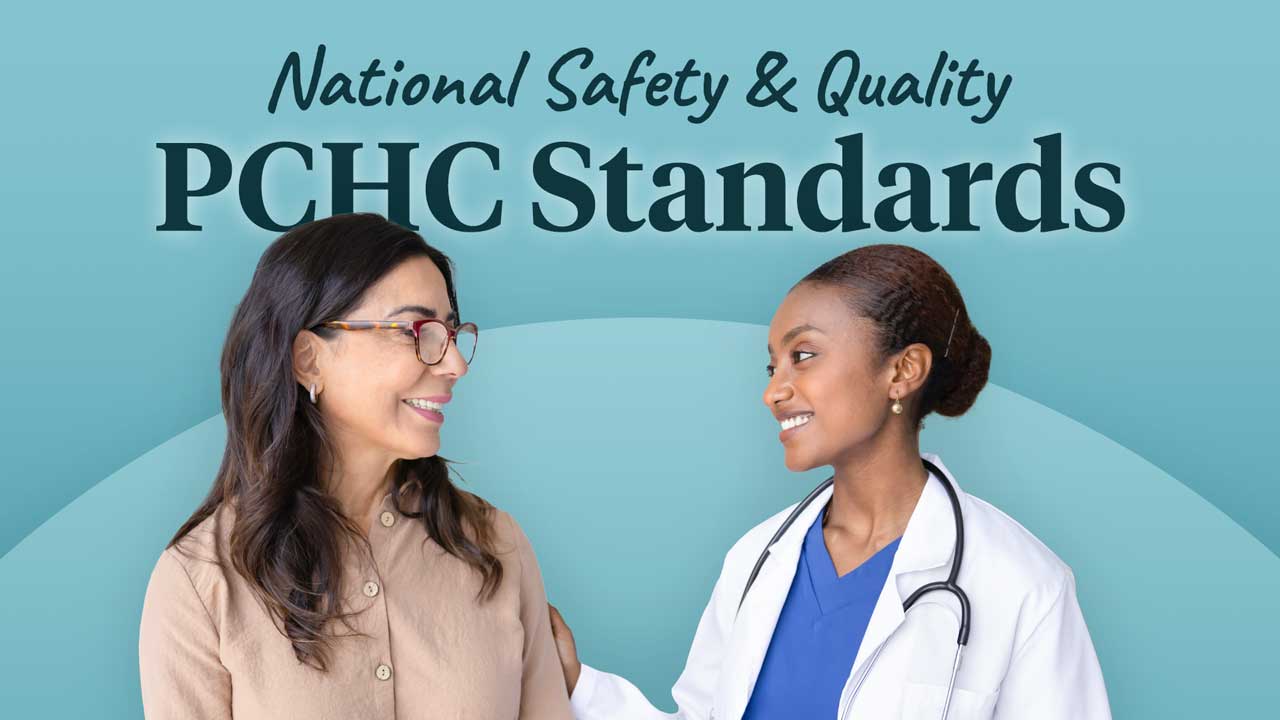This article provides an overview of the National Safety and Quality Primary and Community Healthcare Standards, developed by the Australian Commission on Safety and Quality in Health Care in October 2021.
These Standards aim to protect the public from harm and improve the quality of care across primary and community healthcare services by providing a nationally consistent framework.
They apply to a wide range of services delivering direct care in community settings, including prevention, treatment, chronic condition management and health promotion.
What?
The National Safety and Quality Primary and Community Healthcare (PCHC) Standards.
Who?
The PCHC Standards were developed by the Australian Commission on Safety and Quality in Health Care (ACSQHC) through extensive consultation with consumers, healthcare professionals, primary health networks, government representatives and professional bodies.
Why?
The PCHC Standards aim to protect the public from harm and improve the quality of care provided in primary and community healthcare settings by establishing a nationally consistent framework for safety and quality.
How?
The PCHC Standards provide a nationally consistent framework for services delivering direct patient care. They guide improvements in governance, consumer partnerships and clinical safety across a broad range of services.
What are the Three PCHC Standards?
- Clinical Governance
- Partnering with Consumers
- Clinical Safety.
This article will provide a brief outline of each Standard.
1. Clinical Governance

‘Healthcare services have a responsibility to the community for continuous improvement of the safety and quality of their services, ensuring they are person centred, safe and effective.’
Consumer outcome: 'I am confident the healthcare service is well run and that I will receive safe, high-quality healthcare.’
Purpose: To ensure healthcare services establish a clinical governance framework that supports safe, high-quality care, accountability and continuous improvement.
What Does This Mean?
Clinical governance ensures that relationships and systems between providers, managers and patients are structured to deliver optimal outcomes. Whether a sole provider or a large interprofessional service, responsibilities must be clearly defined and monitored.
This Standard contains the following criteria:
- Governance, leadership and culture
- Patient safety and quality systems
- Clinical performance and effectiveness
- Safe environment for the delivery of care.
(ACSQHC 2021)
2. Partnering with Consumers

‘Healthcare services develop, implement and maintain systems to partner with consumers in their own healthcare.’
Consumer outcome: ‘I am a partner in my own healthcare and my opinion is valued in designing and delivering healthcare.’
Purpose: To support consumers to be active partners in their healthcare and service design, ensuring their rights, preferences and needs are respected.
What Does This Mean?
This Standard emphasises respectful partnerships built on dignity, choice, collaboration and information-sharing. Consumers, whether patients, carers or families, should be supported to engage in their care to the extent that they choose
Partnering with consumers means more than just delivering care; it involves shared decision-making, clear communication and opportunities for feedback and input at every level. Importantly, this Standard aligns with the Australian Charter of Healthcare Rights, which outlines the rights of all individuals accessing care in Australia.
The Charter ensures that consumers are informed, heard and involved in decisions about their care. Healthcare services must uphold these rights in daily practice.
Effective partnerships improve the safety and experience of care. These partnerships can occur:
- At the individual level: Service users and their support people are treated with respect, given relevant information and supported to actively engage in their care, self-management and decision-making.
- At the service level: Service users and their support people are involved in the planning, design, monitoring and evaluation of digital mental health services to help ensure these services are accessible and user-friendly.
- At the service design and delivery level (e.g. consumer consultation in planning).
By promoting health literacy and ensuring access to clear, relevant, and culturally appropriate information, individuals are better equipped to understand their health, navigate services, make informed choices, and actively participate in their care.
This Standard contains the following criteria:
- Clinical governance and quality improvement systems to support partnering with consumers
- Partnering with patients in their own care
- Health literacy
- Partnering with consumers in service design.
(ACSQHC 2020, 2021)
3. Clinical Safety

‘Healthcare services implement systems and processes to maximise safe, high-quality care and minimise clinical safety risks.’
Consumer outcome: ‘The clinical care I receive is safe and of high quality.’
Purpose: To address and reduce common clinical safety risks in primary and community care settings, including infections, medication safety, care coordination and response to deterioration.
What Does This Mean?
This Standard provides practical guidance for managing high-risk areas using a risk-based approach. It aligns with infection control standards, medication safety protocols and communication systems critical for timely and appropriate care.
Key Clinical Risk Areas:
Preventing and controlling infections:
Key components include:
- Applying standard and transmission-based precautions
- Implementing hand hygiene programs aligned with national initiatives
- Maintaining a clean, hygienic environment using approved cleaning agents
- Managing workforce immunisation and infection risks
- Reprocessing reusable medical devices appropriately (if applicable)
- Promoting antimicrobial stewardship to reduce inappropriate antimicrobial use.
Medication safety:
Key components include:
- Taking a Best Possible Medication History and documenting it accurately
- Partnering with patients to maintain current, accurate medicine lists
- Storing and disposing of medicines safely and securely, including high-risk medicines
- Providing patients with tailored medicine information
- Identifying and responding to adverse drug reactions
- Reporting safety issues to the Therapeutic Goods Administration (TGA)
- Following legislative and professional requirements for medication handling.
Comprehensive care:
Key components include:
- Working collaboratively with other providers for coordinated care planning
- Conducting clinical assessments and identifying patient goals
- Developing care plans that reflect patient preferences and risks
- Considering social, cultural and health backgrounds (e.g. Aboriginal and Torres Strait Islander status, disability)
- Including health promotion, prevention and early intervention
- Incorporating advanced care plans where relevant
- Planning and delivering end-of-life care, where this is within the scope of the service.
Communicating for safety:
Key components include:
- Using at least three patient identifiers for correct patient matching
- Documenting essential clinical information in healthcare records
- Supporting structured, best-practice referrals and interprofessional communication
- Ensuring patients receive appointment reminders and follow-up details
- Communicating critical risks and alerts promptly to relevant care providers and families
- Providing opportunities for patients and carers to share concerns or updates with their care team.
Recognising and responding to serious deterioration
Key components include:
- Training staff to recognise and escalate care based on their scope of practice
- Notifying other care providers and carers when a patient’s condition changes
- Establishing processes for:
- Responding to distress, self-harm, suicidal ideation or risk to others
- Providing crisis referrals when care needs exceed service capabilities
- Managing emergencies aligned with legal and safety requirements.
(ACSQHC 2021)
Applying the Standards
The PCHC Standards are voluntary and designed to adapt to the diverse range of services that deliver care in primary and community settings.
Tailored Implementation
Application of the Standards will differ between services, depending on a range of factors such as:
- The size and structure of the healthcare service
- The scope and risk profile of the services delivered
- The type of health professionals involved
- The mode of service delivery (e.g. in-person, telehealth, outreach).
For instance, a sole practitioner offering general practice from a home clinic will apply these Standards differently from a large, interprofessional organisation with multiple physical locations. Similarly, some actions (such as those related to My Health Record or invasive procedures) may not be relevant to all services and are therefore considered not applicable in certain contexts.
Services should use the actions outlined in each Standard to assess their current practice, identify gaps and implement improvements. This includes aligning existing quality and risk systems, ensuring patient engagement in care planning, addressing high-risk clinical areas (e.g. infection control, medication safety), and creating safe care environments.
(ACSQHC 2021)
Conclusion
Together, the three PCHC Standards provide a robust framework that enables healthcare services to:
- Establish governance systems that ensure safe care
- Build partnerships with consumers that are respectful and inclusive
- Identify and mitigate clinical safety risks that may compromise care.
These Standards are intended to align with profession-specific standards and can reduce the duplication of effort across multiple regulatory frameworks.
For full implementation support and further examples, visit the Australian Commission on Safety and Quality in Healthcare.
Test Your Knowledge
Question 1 of 3
Which one of the following best reflects the intent of medication safety actions in the Primary and Community Healthcare Standards?
Topics
Further your knowledge
 Free
Free


References
- Australian Commission on Safety and Quality in Health Care 2020, Australian Charter of Healthcare Rights, 2nd edn, Australian Government, viewed 1 August 2025, https://www.safetyandquality.gov.au/publications-and-resources/resource-library/australian-charter-healthcare-rights-second-edition-a4-accessible
- Australian Commission on Safety and Quality in Health Care 2021, National Safety and Quality Primary and Community Healthcare Standards, Australian Government, viewed 1 August 2025, https://www.safetyandquality.gov.au/publications-and-resources/resource-library/national-safety-and-quality-primary-and-community-healthcare-standards

